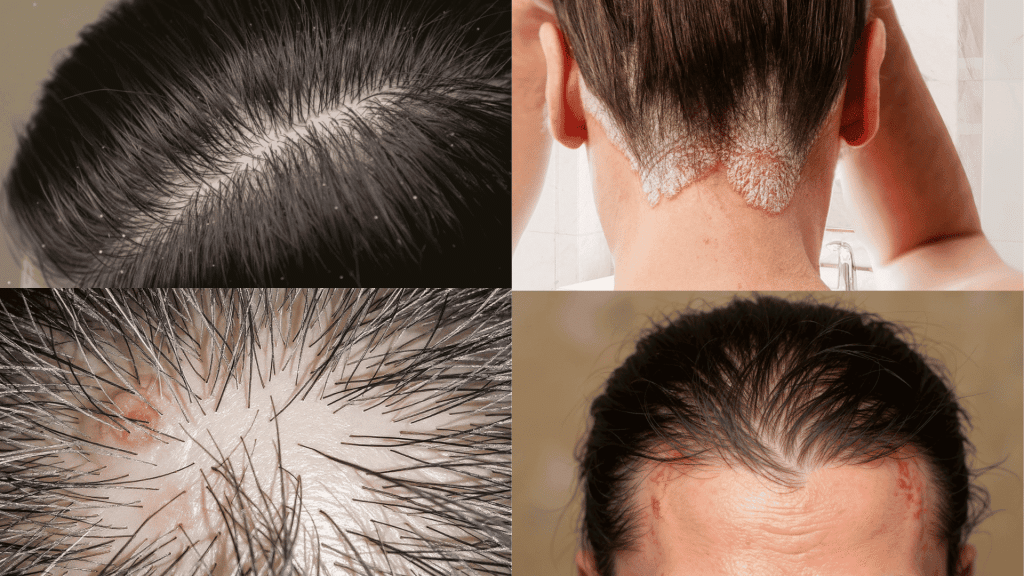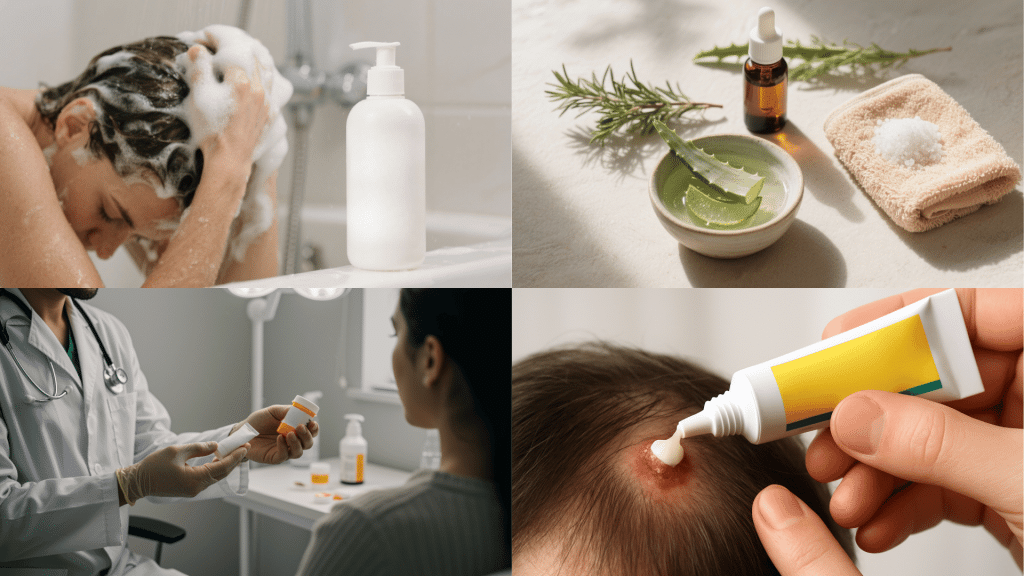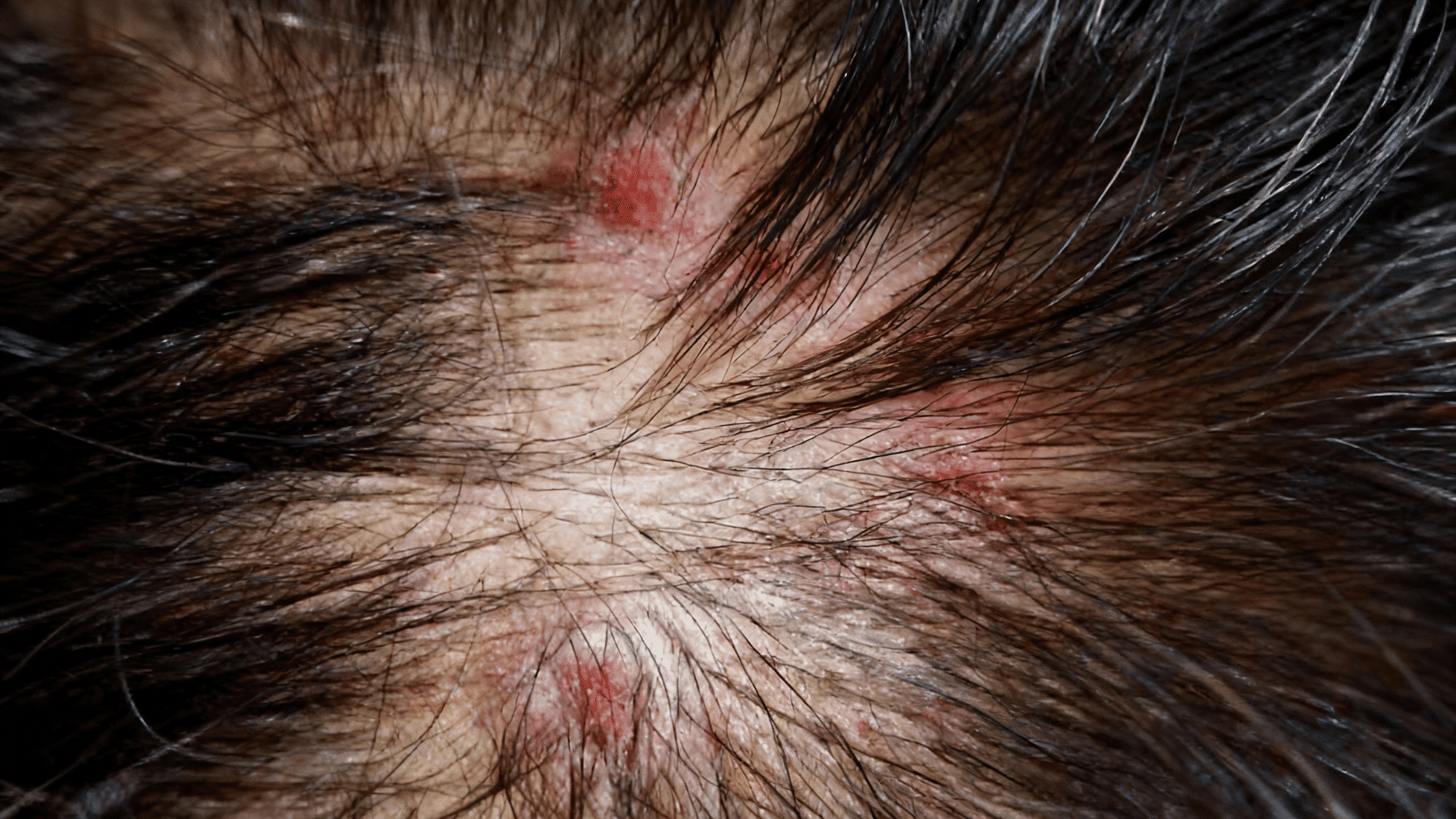A recurring scab on scalp in same spot feels like a never-ending battle.
People notice the same tender spot forming scabs repeatedly. It starts small but becomes an annoying cycle that disrupts their daily routine and confidence.
This guide explains why certain areas of the scalp become problem zones and fail to heal properly. Readers will find effective treatments that actually stop the recurring pattern for good.
Find the real reasons behind stubborn scalp scabs and find proven solutions. From simple home remedies to professional treatments, readers will learn exactly when medical help is needed.
Disclaimer: Some images in this blog may be graphic or disturbing. They are for educational purposes only and not for self-diagnosis or treatment. Please consult a healthcare professional for any symptoms. Viewer discretion is advised.
The Truth About Recurring Scabs on the Scalp
When a scab on scalp keeps forming in the exact same spot, there’s usually a deeper reason. This recurring scab on scalp in same spot often puzzles people who can’t figure out why it won’t just heal and stay gone.
The scalp has sensitive skin that can react to stress, hormonal fluctuations, or underlying medical conditions. Many people think picking makes scabs heal faster, but it actually creates a never-ending cycle.
Hair follicles in that area might be damaged or infected. This causes the body to keep forming protective scabs.
Weather changes, harsh shampoos, and even sleeping positions can make certain spots more vulnerable.
The truth is simple: recurring scalp sores need different treatment than regular cuts. Understanding the root cause helps people choose the right approach and finally get relief.
Causes of Scalp Scabs

A scab that keeps coming back on the scalp can occur for several reasons, ranging from common issues like dandruff and psoriasis to infections or everyday irritation.
This recurring scab on scalp in same spot phenomenon is more common than you’d think and shouldn’t be ignored. Each cause has its own unique signs and requires a different solution, which is why understanding the differences is crucial.
1. Dandruff
When the scalp produces too much oil, it can lead to flakes that irritate the skin. Constant itching or scratching may turn these flakes into sore, scabby spots.
- Cause: Extra oil on the scalp leads to an overgrowth of yeast, which irritates the skin.
- Key Signs: White or yellow flakes, itching, and patches that may become sore if scratched.
- How to Fix: Use an anti-dandruff shampoo, and wash hair regularly with gentle products.
2. Scalp Psoriasis
This condition accelerates skin cell growth, resulting in thick, patchy scales. These patches often reappear in the same locations, resulting in repeated scabs.
- Cause: An overactive immune system makes skin cells multiply too fast, creating thick patches
- Signs: Red, raised areas with silver-white scales that often come back in the same spots. Itchiness and hair shedding are common.
- How to Fix: Medicated shampoos with coal tar or salicylic acid, prescription creams
3. Contact Dermatitis
Hair dye, shampoo, or styling products can trigger irritation. Once the skin reacts, the sore may come back whenever the product is used again.
- Cause: Reaction to hair dye, shampoo, conditioner, or styling products.
- Signs: Red, itchy, and burning patches on the scalp, sometimes accompanied by small blisters or scabs.
- How to Fix: Stop using the product that triggers irritation, switch to fragrance-free products, and use soothing scalp treatments.
4. Folliculitis
When hair follicles get clogged or infected, small bumps can form. These bumps may break open and heal as scabs, often in the same area.
- Cause: Bacteria, yeast, or clogged hair follicles from sweat, oil, or product buildup.
- Signs: Small red bumps or pimples on the scalp that may be painful, itchy, or filled with pus.
- How to Fix: Wash hair regularly, avoid tight hats or helmets
5. Fungal Infections
A fungus can invade the scalp and create ring-shaped, scaly patches. These spots often itch, and scratching makes them crust over.
- Cause: Fungal spores infecting the scalp, often spread through shared brushes, hats, or close contact.
- Signs: Circular, scaly patches with redness and hair loss in the same area. It may be itchy or tender.
- How to Fix: Antifungal shampoos or oral antifungal medication (usually prescribed by a doctor). Avoid sharing combs or hats.
6. Physical Irritation or Injury
Tight hairstyles, hats, or helmets can rub the same spot over and over. Repeated friction prevents the scalp from fully healing.
- Cause: Repeated friction from helmets, hats, or tight hairstyles; scratching or picking at the scalp.
- Signs: Tender scabs in the same spot, sometimes with redness or soreness.
- How to Fix: Avoid tight hairstyles, wear softer headwear, and resist scratching to allow the scalp to heal fully.
Understanding the root cause is the first step toward real relief. While some scalp scabs are caused by common issues like dandruff or minor irritation, others may point to skin conditions or infections that need attention.
The good news is that most of these problems are treatable with the right care, whether at home or with help from a doctor. Taking action early can stop the cycle of scabs and give the scalp a chance to fully heal.
Know About the Different Treatment Options Available

Breaking the cycle of scalp sores requires the right treatment approach. When dealing with a recurring scab on scalp in same spot, different methods work better for different causes and severity levels.
The key is finding what works best for each person’s specific situation.
1. Topical Antibiotics
Over-the-counter antibiotic ointments, such as Neosporin, help prevent infection in open wounds. Apply twice daily to clean, dry skin for best results.
- Pros: Easy to find at any pharmacy, works quickly on bacterial infections, and prevents scarring when used early
- Cons: Can cause skin irritation in some people, may not work on fungal or viral causes, requires consistent daily application
- Suitable for: Fresh scabs with signs of bacterial infection
2. Medicated Shampoos
Special shampoos contain ingredients such as ketoconazole, selenium sulfide, or coal tar. Leave on scalp for 3-5 minutes before rinsing. Results appear after 2-4 weeks of regular use.
- Pros: Treats root causes, not just symptoms, easy to use during regular hair washing, available without a prescription
- Cons: Takes several weeks to show results, can dry out hair with overuse, and some have a strong medicinal smell
- Suitable for: People with underlying scalp conditions or persistent dandruff
3. Prescription Treatments
Doctors prescribe stronger medications, such as topical steroids or oral antibiotics, for stubborn cases. They may combine treatments and run tests to identify specific causes.
- Pros: Most effective for severe cases, targets specific diagnosed conditions, and professional medical guidance is included
- Cons: Requires a doctor visit and prescription, may have more side effects, usually more expensive than home remedies
- Suitable for: Chronic cases that don’t respond to other treatments
4. Home Remedies
Natural treatments, such as tea tree oil, aloe vera, or warm saltwater compresses, provide gentle relief. Dilute tea tree oil to prevent burning sensations.
- Pros: Gentle on sensitive scalp skin, usually inexpensive and accessible, and has few side effects when used properly
- Cons: Less research on effectiveness, results vary greatly between people, and it may take longer to see improvement
- Suitable for: Mild cases or people who prefer natural approaches
The most effective treatment plan often combines multiple approaches. Starting with gentler options and progressing to stronger treatments usually works best.
People should monitor their progress and adjust their approach as needed.
Others’ Experiences with Scalp Problems: What You Can Learn
Hearing how others manage similar scalp problems can be eye-opening. In the following section, you will find real stories and advice from online communities to help you find solutions
1. Someone has dealt with scabs on their scalp for over a year, which only improve with hydrocortisone cream but keep returning. What could be the reason?
Community members suggested causes like product preservatives, fungal issues, or irritation. They recommended trying antifungal shampoos, switching to gentler products, and avoiding ingredients known to trigger reactions.
2. A person noticed a scab at the back of their head that hasn’t healed for months. Should theyworry?
Replies noted it’s usually not cancer, but worth showing to a dermatologist. They advised avoiding picking, reviewing shampoos with harsh sulfates, and using milder alternatives for healing.
3. Can scratching the same scalp scab for a long time cause hair loss?
Yes, constant scratching may damage the follicles, leading to thinning or even permanent loss if scarring develops. Allowing the skin to rest and heal protects healthy growth.
4. What shampoos seemed to help people with recurring scalp scabs?
Members mentioned relief from ketoconazole shampoos, products free of irritating preservatives, and formulas with salicylic acid, sulfur, coal tar, or zinc to calm irritation and reduce scabbing.
5. Are there non-product triggers for recurring scalp scabs?
Yes, experiences included hard water, dietary changes such as dairy, stress, and friction from hats or hairstyles. Identifying these everyday irritants often made a big difference.
6. When should someone with a scalp scab get medical advice?
If a sore doesn’t heal after several weeks, shows signs of infection like pus or redness, or keeps changing, community members stressed that a dermatologist’s opinion is best.
7. Is dandruff always to blame for scalp scabs that return?
Not always. Some found dandruff was the cause, while others had psoriasis, fungal infections, or allergies. Examining patterns such as redness, scaling, or patch location helped narrow down the options.
Prevention Tips to Stop it From Coming Back
Prevention starts with gentle hair care habits that protect the scalp from further irritation. Simple lifestyle changes can make a significant difference in stopping the problem from returning.
Key prevention strategies include:
- Using lukewarm water instead of hot water when washing hair
- Switching to sulfate-free shampoos to reduce chemical irritation
- Keeping fingernails short to prevent accidental scratching
- Wearing cotton gloves at night to avoid unconscious picking during sleep
- Practicing stress management techniques like meditation or exercise
- Maintaining proper scalp moisture with gentle, fragrance-free products
These changes create an environment that promotes healing and prevents new irritation from developing.
When to See a Doctor?
Anyone experiencing a recurring scab on scalp in same spot should seek medical attention if certain warning signs appear.
Persistent bleeding, increasing size, or changes in color require immediate evaluation and attention. A healthcare provider should examine scabs that haven’t healed after two weeks of proper care.
Red flags include pus or foul-smelling discharge, severe pain or tenderness, spreading redness around the area, and fever accompanying the scalp issue.
These symptoms may indicate an infection or a more serious underlying condition that requires professional treatment.
Dermatologists can perform a proper diagnosis through examination or, if necessary, biopsy.
Early intervention prevents complications and ensures appropriate treatment for the underlying conditions that cause the recurring problem.
Conclusion
Breaking the cycle of a recurring scab on scalp in same spot requires understanding the root causes and taking consistent action.
Many people successfully overcome this challenge by combining proper medical care with lifestyle changes.
The strategies covered in this guide provide a clear path forward. From identifying triggers to implementing prevention techniques, readers now have the tools needed to address this frustrating problem effectively.
Remember that healing takes time, and setbacks are a normal part of the process. The key is staying committed to gentle care practices while avoiding behaviors that worsen the condition







